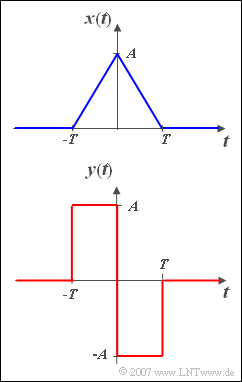Exercise 3.5: Differentiation of a Triangular Pulse
From LNTwww
We are looking for the spectrum $Y(f)$ of the signal
- $$y\left( t \right) = \left\{ \begin{array}{c} A \\ - A \\ 0 \\ \end{array} \right.\quad \begin{array}{*{20}c} {{\rm{f \ddot{u}r}}} \\ {{\rm{f\ddot{u} r}}} \\ {{\rm{f\ddot{u}r}}} \\ \end{array}\;\begin{array}{*{20}c} { - T \le t < 0,} \\ {0 < t \le T,} \\ {{\rm{else}}{\rm{.}}} \\\end{array}$$
Let $A = 1\,{\rm V}$ and $T = 0.5\,{\rm ms}$ apply.
The Fourier transform of the triangular pulse $x(t)$ sketched above is assumed to be known, namely
- $$X( f ) = A \cdot T \cdot {\mathop{\rm si}\nolimits} ^2 ( {{\rm{\pi }}fT} ),$$
where $\text{si}(x) = \text{sin}(x)/x$ . A comparison of the two time signals shows that the following relationship exists between the functions $x(t)$ and $y(t)$ :
- $$y(t) = T \cdot \frac{{{\rm d}x(t)}}{{{\rm d}t}}.$$
Hints:
- This exercise belongs to the chapter Fourier Transform Laws.
- All the laws presented there - including the Shifting Theorem and the Integration Theorem – are illustrated with examples in the learning video Gesetzmäßigkeiten der Fouriertransformation .
- In subtask (3) the spectrum $Y(f)$ is to be calculated starting from a symmetrical rectangular pulse $r(t)$ with amplitude $A$ and duration $T$ and its spectrum $R(f) = A \cdot T \cdot \text{si}(\pi fT)$ . This is achieved by applying the Shifting Theorem.
- In Task 3.5Z the spectrum $Y(f)$ is calculated starting from a signal consisting of three Dirac functions by applying the integration theorem.
Questions
Solution
(1) The differentiation theorem reads generally:
- $$\frac{{{\rm d}x( t )}}{{{\rm d}t}}\circ\!\!-\!\!\!-\!\!\!-\!\!\bullet\,{\rm{j}} 2{\rm{\pi }}f \cdot X( f ).$$
- Applied to the present example, one obtains:
- $$Y( f ) = T \cdot {\rm{j}}\cdot 2{\rm{\pi }}f \cdot A \cdot T \cdot \frac{{\sin ^2 ( {{\rm{\pi }}fT} )}}{{( {{\rm{\pi }}fT} )^2 }} = {\rm{j}} \cdot 2 \cdot A\cdot T \cdot \frac{{\sin ^2 ( {{\rm{\pi }}fT} )}}{{{\rm{\pi }}fT}}.$$
- This function is purely imaginary. At the frequency $f = 0$ the imaginary part also disappears. This can be formally proven, for example, by applying l'Hospital's rule ⇒ $Y( f = 0 ) \;\underline{= 0}$.
- However, the result also follows from the fact that the spectral value at $f = 0$ is equal to the integral over the time function $y(t)$ .
- At the normalised frequency $f \cdot T = 0.5$ $($i.e for $f = 1\,\text{ kHz})$ the sine function is equal to $1$ and we obtain $|Y(f = 1 \,\text{kHz})| = 4/\pi \cdot A \cdot T$, i.e. approximately $|Y(f=1 \ \text{kHz})| \ \underline{=0.636 \,\text{ mV/Hz}}$ (positive imaginary).
(2) The correct solutions are 1 and 3:
- The zeros of $X(f)$ remain and there is another zero at the frequency $f = 0$.
- The upper bound is called the asymptotic curve
- $$\left| {Y_{\max }( f )} \right| = \frac{2A}{{{\rm{\pi }} \cdot |f|}} \ge \left| {Y( f )} \right|.$$
- For the frequencies at which the sine function delivers the values $\pm 1$ , $|Y_{\text{max}}(f)|$ and $|Y(f)|$ are identical.
- For the square-wave pulse of amplitude $A$ the corresponding bound is $A/(\pi \cdot |f|)$.
- In contrast, the spectrum $X(f)$ of the triangular pulse falls asymptotically faster:
- $$\left| {X_{\max }( f )} \right| = \frac{A}{{{\rm{\pi }}^{\rm{2}} f^2 T}} \ge \left| {X( f )} \right|.$$
- This is due to the fact that $x(t)$ has no discontinuity points.
(3) Starting from a symmetrical rectangular pulse $r(t)$ with amplitude $A$ and duration $T$ the signal $y(t)$ can also be represented as follows:
- $$y(t) = r( {t + T/2} ) - r( {t - T/2} ).$$
- By applying the displacement theorem twice, one obtains:
- $$Y( f ) = R( f ) \cdot {\rm{e}}^{{\rm{j\pi }}fT} - R( f ) \cdot {\rm{e}}^{ - {\rm{j\pi }}fT} .$$
- Using the relation $\text{e}^{\text{j}x} – \text{e}^{–\text{j}x} = 2\text{j} \cdot \text{sin}(x)$ it is also possible to write for this:
- $$Y( f ) = 2{\rm{j}} \cdot A \cdot T \cdot {\mathop{\rm si}\nolimits}( {{\rm{\pi }}fT} ) \cdot \sin ( {{\rm{\pi }}fT} ).$$
- Consequently, the result is the same as in subtask (1).
- Which way leads faster to the result, everyone must decide for himself. The author thinks that the first way is somewhat more favourable.
- Subjectively, we decide in favour of solution suggestion 1.
